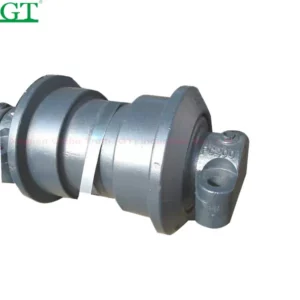Ensuring the compatibility of track rollers with different track shoe configurations involves careful consideration of design, dimensions, and materials.
Here are several key factors and steps that manufacturers take to achieve this compatibility:
- Standardization: Adherence to industry standards ensures that track rollers are designed to meet specific criteria that are widely accepted within the heavy machinery sector. This includes dimensions, load-carrying capacities, and other essential parameters.
- Detailed Specifications: Track rollers must be designed with detailed specifications that consider the specific requirements of different track shoe configurations. This involves understanding the dimensions, shape, and attachment methods of the track shoes.
- Material Selection: The choice of materials for both the track rollers and track shoes is crucial. Materials must be selected based on their strength, durability, and compatibility with each other to prevent premature wear or failure.
- Load Distribution: Track rollers need to distribute loads evenly across the track shoes. China excavator track roller for sale The design should consider the variations in load distribution that can occur based on different configurations, ground conditions, and operating environments.
- Adjustability: Some track systems allow for adjustments to accommodate variations in track shoe configurations. This can include adjustable or interchangeable components to ensure a proper fit and alignment.
- Compatibility Testing: Rigorous testing is conducted to verify compatibility with different track shoe configurations. This may involve prototype testing, simulated operating conditions, and real-world field testing to ensure that the track rollers perform reliably under various circumstances.
- Modularity: Designing track rollers with modular components allows for flexibility in accommodating different track shoe configurations. Modular designs can be adapted or replaced to meet the specific requirements of different applications.
- Computer-Aided Design (CAD): Advanced CAD software is employed to model and simulate the interaction between track rollers and track shoes. This helps identify potential issues and optimize the design for compatibility.
- Customer Feedback and Collaboration: Collaboration with equipment manufacturers and feedback from end-users are valuable sources of information. Understanding the diverse needs of customers helps in tailoring track roller designs to different track shoe configurations.
- Continuous Improvement: As technology advances and new track shoe configurations emerge, manufacturers must engage in continuous improvement processes. Staying abreast of industry trends and technological advancements ensures that track rollers remain compatible with evolving track shoe designs.
By addressing these factors, manufacturers can develop track rollers that are versatile and compatible with a range of track shoe configurations, providing reliable performance across various applications and operating conditions.
